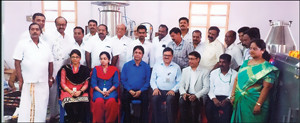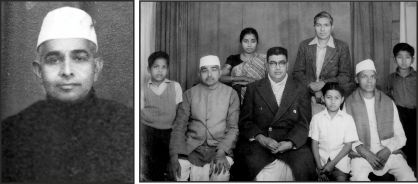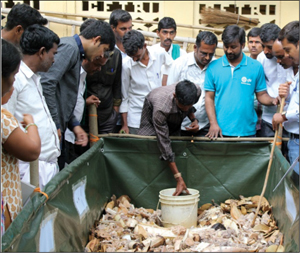The Hospitality Industry is a burgeoning one and Mysuru, which has always been dotted with eateries, has now become a destination for some of the finest resorts and spas. However, there is one person who is really a trendsetter in this direction, which has led him to building a powerful brand in the hotel industry. He is the suave, very thinking, unassuming, private individual P.V. Giri, who started Hotel Siddharta, is also the Chairman of The Windflower Group.

Watching the Falls as the water cascades at city’s Windflower Resort near Race Course, Giri, who has transformed very dry, ordinary looking places into something very magical, reveals to Star of Mysore, how an open well has been transformed into a valley-like swimming pool. Speaking about the Windflower chain of Hotels, he dwells on his foray into the Hotel Industry, the avenues he has explored, the tourism scenario in Mysuru and his family support. Excerpts. —Ed
by N. Niranjan Nikam, Senior Journalist
SOM: Mysuru is not only the cultural capital of Karnataka but also a culinary delight. As old-timers recall the taste eating idlis, vadas, dosas in hotels like Indra Bhavan, Raju Hotel, Anand Bhavan, Durga Bhavan, Mylari, GTR, Galli hotel, the taste still lingers. What made you take up the challenge of setting up Hotel Siddharta in 1982, as a complete outsider?
P.V. Giri: If you recall those days Dasaprakash Hotel was the only hotel which was equally strong in restaurants and lodging and to a certain extent Indra Bhavan Boarding and Lodging. Hence, there was a space, especially in tier two cities. Since the land was available in the heart of the city we started to build Hotel Siddharta. The hotel’s proximity to many important tourist destinations like the Mysore Palace, Zoo, Museums, Chamundi Hill, also helped.
We wanted to make this a vegetarian hotel because serving non-veg food and having a bar was a taboo those days and it was also not considered good for honeymoon couples to stay in hotels which had a bar and served non-veg food. Then we came up with the idli and dosa food festivals and then we started serving the menu that suited the current tastes as time passed.
SOM: How much has Mysuru changed from a tourism perspective?
P.V. Giri: Mysuru has not changed much as a tourist location in spite of numerous representations by various bodies. For instance, there is no parking facility at the Zoo, which sees lakhs of tourists coming in buses and cars.
SOM: What is the reason for this kind of neglect?
P.V. Giri: It probably needed the intervention of a very dynamic local politician to provide tourism requirements and persist in following it to its logical end, which has never happened. Take the Mysuru-Bengaluru road. If the roads were broader and wider, the travel time could be reduced by at least an hour and the discomfort of travel by at least 50 per cent.
SOM: One of the toughest industries is the Hotel Industry, which requires a lot of manpower. What changes have you seen in the industry since you started till now?
P.V. Giri: The question has to be rephrased in the sense the main deterrent is the capital cost. As far as manpower is concerned, in Mysuru it is very difficult to get skilled manpower, but we had started the process and slowly the acceptance of the staff to move from other cities to Mysuru began because of the pay packets and the opportunity to move up the ladders. Much also depends on how the management treats the staff and as we look after them well and are treated like family and the personal rapport we have with them, the attrition rate in our organisation is one of the lowest in the industry.
SOM: Diversification is the key. Many big business families, especially in Mysuru have failed because they did not diversify. When did you get the idea of diversification?
P.V. Giri: We diversified only in our own industry. We did not move out of our area of specialisation except in the broad area of hospitality. As the double income families increased in metros and they wanted to have short breaks and that too for people who always insist on star hotels, we provided them big rooms, different types of menu and relaxation facilities in abundance. This is the slot that was empty and we moved in.
SOM: You have been in the hospitality business for a long time. You were not happy with just one Siddharta or a Joy Ice-Cream. You forayed into Resorts and Spa and the result is the Windflower chain. How did this happen?
P.V. Giri: As I told you earlier, the space was there and we spotted it. As I sat in my office in Siddharta, I noticed that travellers were seeking a more resort-like ambience, but had to do with city business hotels because of a lack of choice. It was this observation which led to the conception of Windflower. I already owned a successful open air restaurant Olive Garden, located at the foot of Chamundi Hill and saw the potential to convert the extra land around this into a small, quiet retreat.
I also realised that what Mysuru lacked was a spa which could be an excellent value addition, given that this city attracted several thousand yoga students and health travellers every year. I worked closely with my close friend Ramesh Rao (who had been instrumental in incubating Café Coffee Day as a brand) and after several brainstorming sessions, we arrived at the name Windflower as it evoked a certain outdoorsy feel and a closeness to nature which was what the resort is all about.
At the time Windflower was being conceptualised, my vision was to build a hotel chain and I envisioned that a time would come when the upcoming middle class family would want to take their new car out for a long drive and combine it with a holiday. After the huge success of Windlflower Mysuru, the second location chosen was Windlflower Coorg. This quickly followed by Windflower Vythiri, Bandipur and Pondicherry.
SOM: Some of the properties that you have mentioned are world class. I believe you create magic out of nothing. What inspires you?
P.V. Giri: First of all, the location inspires me. Second, it is the support from my son Tharun Giri, who is the Managing Director. We both have travelled a lot and we see what is suitable for the location and the customs. A lot of landscaping was done by horticulturist Rukmini Devi, who did it at the Olive Garden in its earlier stages.
One decision we took was that every room should have a view, since 90 per cent come from the cities and they are used to seeing only their neighbours windows. We kept in mind the location of the guest rooms that had to be as close to nature as possible.
For example, in Pondicherry all the rooms have a view of the beach and in Coorg of the coffee plantation. This is an essential thing for the customer as he needs to relate to nature which he does not have at home.
SOM: You have said that the Hotel Industry is a high risk, capital intensive business. In spite of this, you always look cheerful and calm. What is the secret?
P.V. Giri: When we started building the Windflower we used the experience we had in the construction industry and the expertise to get furniture imported to lower the costs and we kept the cost of land low by going a little interior into the towns and cities. This gave us the advantage of effectively building resorts at low costs. A little bit of planning on all fronts and anticipating the economic situation and preparing for it also helps.
A lot of responsibility at the home front was taken care of by my wife Rukmini Giri because of my hectic travelling schedule. She brought up the children and took care of my parents. Hence, the credit also goes to her.
SOM: Mysuru has always been a tourist destination. It has always been a Smart City nearly 100 years ago as the most benevolent rulers, the Wadiyar dynasty with the welfare of the people in mind built roads, provided water, electricity and created jobs. What is it that we are lagging now?
P.V. Giri: Mysuru has only been a tourist centre and there is very little industrialisation. It could have grown more if the connection between Mysuru and Bengaluru had been given importance. This would have resulted in much more industrialisation. Hence, it is poor connectivity which has stopped Mysuru from growing.
SOM: You were a part of Mysore Agenda Task Force (MATF). What happened to that?
P.V. Giri: It was set up when S.M. Krishna was the Chief Minister. A lot of things happened. We put together a very good report as to what needs to be done in Mysuru. A huge data was supplied to the government to really improve Mysuru. Unfortunately, the MATF did not have the power to implement or execute whatever was put on paper. Now the report has gone into cold storage.
SOM: Your father, late P. Vardarajan was a very spiritual person. How much did he motivate you to take up social service activities?
P.V. Giri: He was actually the backbone for setting up three hospitals in Kesare. My son and me are continuing to support them as part of our CSR (Corporate Social Responsibility) activities. Whenever the hospital staff is in trouble, we make sure that we keep rules and regulations aside and go out of our way to support them. Both, my son Tharun and daughter Mahalakshmi, keep visiting these hospitals set up by their grandfather and it has kept them grounded.
Also, to a large extent we are a very religious family. In fact the family never steps out of the house everyday without the puja being complete. Even when I leave the house at 4 in the morning, my wife finishes the puja and only then I go out. Even my daughter-in-law Shruti Giri, who is now a Syndicate Member of University of Mysore, follows this practice and tradition.
SOM: Tharun Giri, your son who has a Hotel Management degree from Switzerland and Master’s from USA, is playing a key role in your ventures. What is the relationship like between the father and son?
P.V. Giri: The relationship when it comes to business is very professional. We make it a point to discuss issues and when there is something very important, we both drive in the same car and talk about it. Tharun has brought in a lot having worked abroad. All operations are directed by him on a day-to-day basis. We have Vice-Presidents who report to him and there are other different portfolios. But major decisions like choice of locations, or architects are jointly discussed. There is bound to be some arguments back and forth after which decisions are arrived at. But the entire team works 24X7.
We always keep thinking of ways to satisfy the palate of the customers. Take for instance the Military Counter we have introduced. For breakfast we are showcasing the non-vegetarian popular dishes like Nati Koli curry with Thatte Idli, chicken khurma with idiaappam etc. The other is the Healthy Selection: At breakfast all resorts have a healthy section consisting of vegetable shooters, a salad with leafs, sprouts and dressing, whole wheat breads with diet preserves etc. There is also the rice fish that is available in paddy fields during the harvesting time. It is shallow fried in olive oil and served with tartar sauce. Such things make a lot of difference.
SOM: What are the challenges you have faced?
P.V. Giri: Challenges have always been slow in appearing. The government has not come out with a single policy from conceptualisation to execution to operation. The number of licences, the time taken to get them are all mind-boggling. Hotel by itself is very difficult to sustain. Why should the government not come out with a policy. We have been crying hoarse about the exorbitant road tax for tourist buses and cars. If this is reduced, then tourism will definitely grow.
source: http://www.starofmysore.com / Star of Mysore / Home> Feature Articles / July 10th, 2016








